One of the tasks for the MOSBRI partners during the project is to identify methodological improvements based on interactions between users and their hosts. The interplay between user and hosts in transnational access (TNA) is rarely a mono-directional interaction, and new ideas often sprout from a TNA visit, training schools or courses.
Since the beginning of the project, the following new methodologies have been identified and are offered through MOSBRI TNA:
Pipeline at MOSBRI partner EPR-MRS: Redox centre identification, electron transfer and catalytic activities in metalloenzymes and metalloproteins.
Many enzyme activities use electron transfer to proceed and involve redox centres in their functioning. EPR spectroscopy and related techniques (ENDOR, HYSCORE,..) are the methods of choice to identify these co-factors and follow their redox or structural changes during catalytic cycles. Combining this with electrochemical methods, which measures catalytic activity as an electric current and enables rapid enzyme activity determination, provides a powerful pipeline to address enzyme mechanisms and understanding at the molecular scale.
